This year’s exercise includes approximately 25,000 personnel from 26 nations.

Israel has sent troops to take part in the biennial Rim of the Pacific (RIMPAC) multinational naval exercise.
RIMPAC is led by the US 3rd fleet off of the coast of Hawaii and Southern California in August has been held every two years since the early 1970s and is considered the world’s largest maritime exercise.
The exercise, which kicked off last week and is scheduled to go until August 4th in and near the Hawaiian Islands and Southern California, will see a total of 38 ships including three unmanned surface vessels, four submarines, nine national land forces and more than 170 aircraft including MQ-9 Reaper unmanned aerial vehicle.
This year’s exercise includes approximately 25,000 personnel from 26 nations including from Australia, Brunei, Canada, Chile, Colombia, Denmark, Ecuador, France, Germany, India, Indonesia, Israel, Japan, Malaysia, Mexico, Netherlands, New Zealand, Peru, the Republic of Korea, the Republic of the Philippines, Singapore, Sri Lanka, Thailand, Tonga, the United Kingdom, and the United States.
Like in Israel’s previous participation in 2018, naval vessels were not deployed rather troops were sent to take part in ground-based exercises.
Drill designed to foster and sustain multinational cooperation
With the theme of RIMPAC 2022 being “Capable Adaptive Partners,” the drill was designed to foster and sustain multinational cooperation and trust as well as enhance the interoperability of troops who ensure the safety and security of sea lanes and oceans.
“Participating nations and forces will exercise a wide range of capabilities and demonstrate the inherent flexibility of maritime forces,” the US Navy’s 3rd Fleet said, adding that the capabilities “range from disaster relief and maritime security operations to sea control and complex warfighting.”
The drill will see forces train on amphibious operations, gunnery, missile, anti-submarine, air defense exercises, as well as counter-piracy operations, mine clearance operations, explosive ordnance disposal, and diving and salvage operations.
Space and cyber operations to be drilled as well
The drill will also include space and cyber operations.
“During RIMPAC, a network of capable, adaptive partners train and operate together in order to strengthen their collective forces and promote a free and open Indo-Pacific,” read the statement by the 3rd Fleet. “RIMPAC 2022 contributes to the increased interoperability, resiliency and agility needed by the Joint and Combined Force to deter and defeat aggression by major powers across all domains and levels of conflict.”
Israel first time in RIMPAC since 2018
Israel took part in the exercise for the first time in 2018 along with 26 other nations, 47 surface ships, five submarines, 18 national land forces, and more than 200 aircraft and 25,000 personnel.
It did not take part in RIMPAC 2020 due to the outbreak of the coronavirus pandemic.
Israel regularly participates in naval exercises around the world and has increased the number of drills held with regional countries with it’s entry into CENTCOM’s area of responsibility.
In February, the Israeli Navy’s Flotilla 3 and Underwater Warfare Unit took part in the US Navy-led International Maritime Exercise (IMX) alongside more than 9,000 personnel and up to 50 ships from more than 60 militaries and international organizations.
Several countries that recently normalized ties with Israel took part in the drill including the United Arab Emirates, Morocco, and Bahrain. Several others who do not have formal ties are also participating including Bangladesh, Comoros, Djibouti, Oman, Pakistan, Saudi Arabia, Somalia and Yemen. Egypt and Jordan also took part in the drill.
In April, the Navy participated in a large-scale exercise with their American counterparts from the US 5th fleet, drilling on naval combat, maritime refueling and maritime medical scenarios.
The 10-day-long bilateral drill dubbed “Intrinsic Defender” focused on maritime security operations, explosive ordnance disposal, health topics and the integration of unmanned systems.
